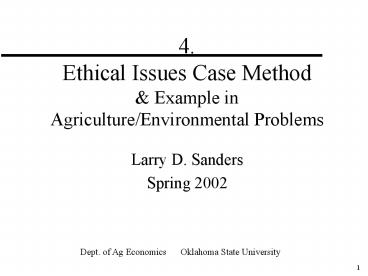4. Ethical Issues Case Method - PowerPoint PPT Presentation
1 / 11
Title:
4. Ethical Issues Case Method
Description:
to understand how the case method is applied to an example of ethical issues in ... 1. Tyranny of European landed aristocracy --State: Penn. 1825 --Federal: ... – PowerPoint PPT presentation
Number of Views:47
Avg rating:3.0/5.0
Title: 4. Ethical Issues Case Method
1
4. Ethical Issues Case Method Example in
Agriculture/Environmental Problems
- Larry D. Sanders
- Spring 2002
Dept. of Ag Economics Oklahoma State
University
2
INTRODUCTION
- Purpose
- to understand how the case method is applied to
an example of ethical issues in agriculture and
the environment - Learning Objectives
- 1. To review the case method outline and
- objectives.
- 2. To apply the method to an appropriate
example. - 3. To understand the generic applicability to a
- variety of issues.
- 4. To understand how ethics sensitivity
enhances - understanding of problem many improve
resolution.
3
Case Method Outline for Lecture/Seminar
- Introduction of Problem
- Discussion of Problem
- Discussion of Ethical Issues related to Problem
- Suggested Resolution of issue with ethics
considered - Homework assignment or in-class activity (answer
key to instructor) - Class handouts
- --notes
- --key definitions
- --sample exam questions (answer key to
instructor) - --references (as appropriate)
4
Case MethodExampleEstate Taxation
- Introduction of Problem
- A. The Problem
- --Many citizens feel it is unfair to tax
property at death, especially in agriculture. As
some say, If I own it at my death, why cant I
pass it on to my heirs without them having to buy
it again or sell off assets to pay Uncle Sam? - B. Key Current Alternatives
- 1. The status quo provides for an increase
in the - exemption phased in over a period of years.
- 2. The Bush Administration is proposing a
total - elimination of the so-called death
tax. - 3. Some have proposed a compromise.
5
Case MethodExampleEstate Taxation
- 2. Discussion of Problem
- A. Background/History
- 1. Tyranny of European landed aristocracy
- --State Penn. 1825
- --Federal
- --Revenue Act of 1916 (to fund national
- emergencies)
- --1932-41 estate taxes increased
- --1976 estate/gift taxes united
- --1981, 1987, 1997 estate tax capped, then
reduced - 2. American democracy equality/equity
6
Case MethodExampleEstate Taxation
- 2. Discussion of Problem
- A. Background/History (continued)
- 3. Current Data
- --50 billion in estate taxes/year
(estimates vary) - --Top 1 (2.6-2.9 million) pay 80-90
of estate taxes - (40-45 bil. by some estimates)
- --Top 0.1 pay half of estate taxes
- --Farms account for less than 0.5 of
taxable estate assets - --Family-owned businesses/farms get
special treatment in - valuation at current use rather
than market value, - possibly payment deferral (non-farm
family-owned - business not eligible for use
valuation)
7
Case MethodExampleEstate Taxation
- 2. Discussion of Problem (continued)
- B. Recent/Current Actions
- 1. 1990sincreased exemption phased in
(state - federal)
- --current 675,000 exemption increases
to - 1 million exemption for all estates by 2006
- (unlimited amount exempted in transfer to
- spouse)
- --current 1.3 million exemption for
family-owned - businesses/farms
8
Case MethodExampleEstate Taxation
- 2. Discussion of Problem
- B. Recent/Current Actions (continued)
- 2. 2000 Presidential election--key part of
debate - --Bush wanted to eliminate death tax
- --Gore wanted to increase exemption
(5-10 - million phased-in over 3-5 years)
- --GOP plan to increase exemption to 5
million - 3. Bush Administration tax cut
- --plans to phase-out estate tax over
period of years - C. Rationale for key alternatives
- --Economic and/or Intrinsic
9
Case MethodExampleEstate Taxation
- 3. Discussion of Ethical Issues Related to
Problem - Moral Justification
- For Status Quo (or higher estate tax)
- --Land portion of assets is not for private
holding/use should be shared by all and or
returned to nature - --Ownership gives no rights beyond death
- For Phase-down/elimination
- --Property rights are absolute and/or dispensed
by God, not man - --The work ethic justifies rewards for hard work
, by rights, land freely bought and paid for,
should be used/sold/passed on at owners desire
without impediment
10
Case MethodExampleEstate Taxation
- 3. Discussion of Ethical Issues Related to
Problem (continued) - B. Empirical Justification
- For Status Quo
- --Recoups unpaid capital gains taxes
- --Fairness concept requires method to minimize
wealth concentration - --Progressive concept requires method for
wealthier to pay more - --Elimination of tax could be regressive if
government needed to compensate for loss of
revenue - --May be a way to force wealthy to pay for
loopholes - For Phase-down/elimination
- --Those who pay most should get the biggest tax
cuts - --The wealthier create wealth that spurs economy
(trickle-down theory) - --Gifting to charity may be higher
- --IRS expense to capture estate taxes may not
justify the revenue
11
Case MethodExampleEstate Taxation
- 4. Suggested Resolution with Ethics Considered
- A. Problem/Issue Identified (public becomes
aware) - B. Problem defined
- --Include Science, Technology, Ethics,
Policy - C. Decision-Making Process
- --Include Science, Technology, Ethics,
Policy - D. Monitor Evaluate
- 5. Homework
- 6. Notes/References/etc.
- --IRS studies
- --Institute for Taxation Economic Policy
- --Congressional Research Service
- --The Oklahoma Observer































